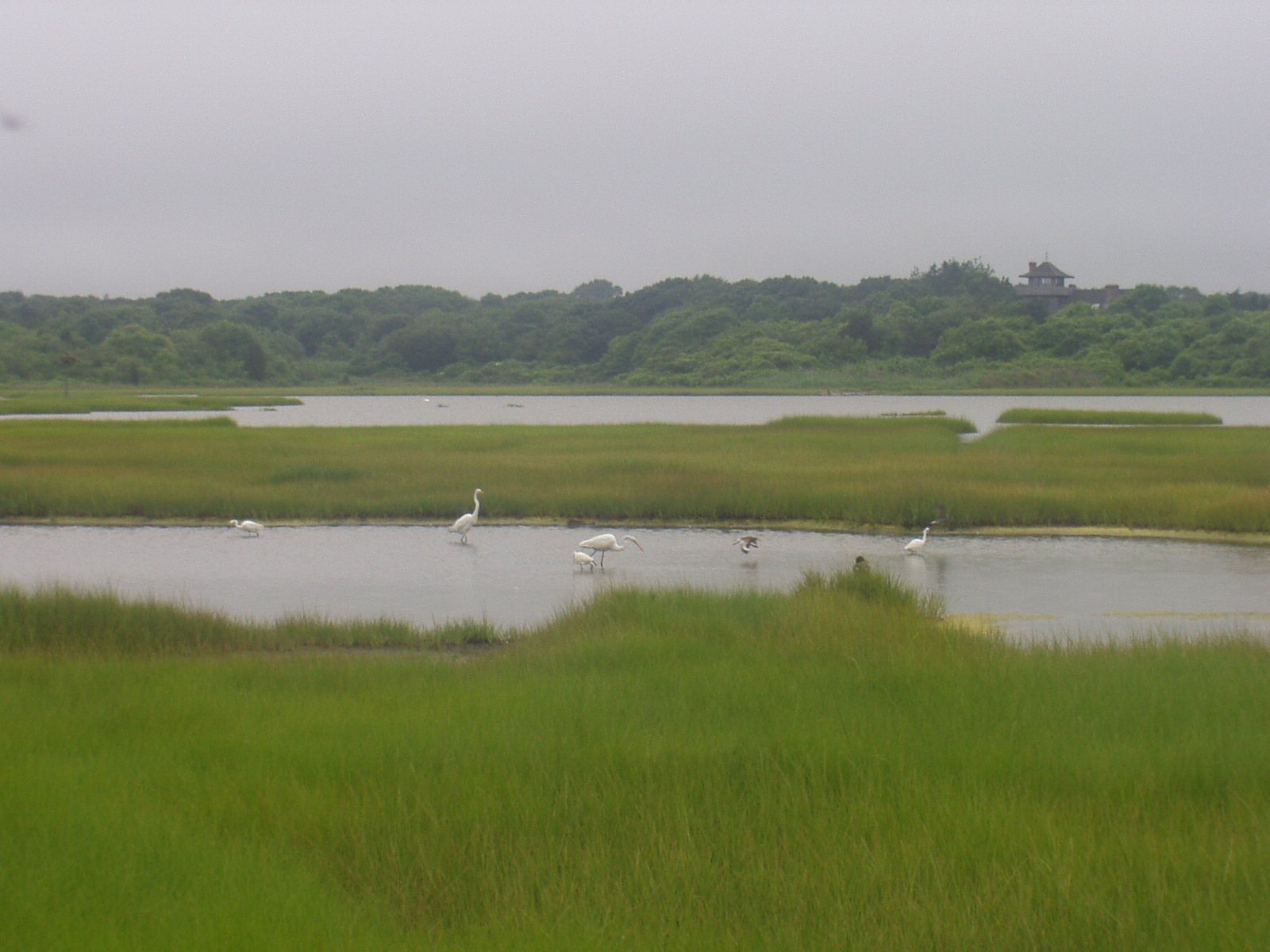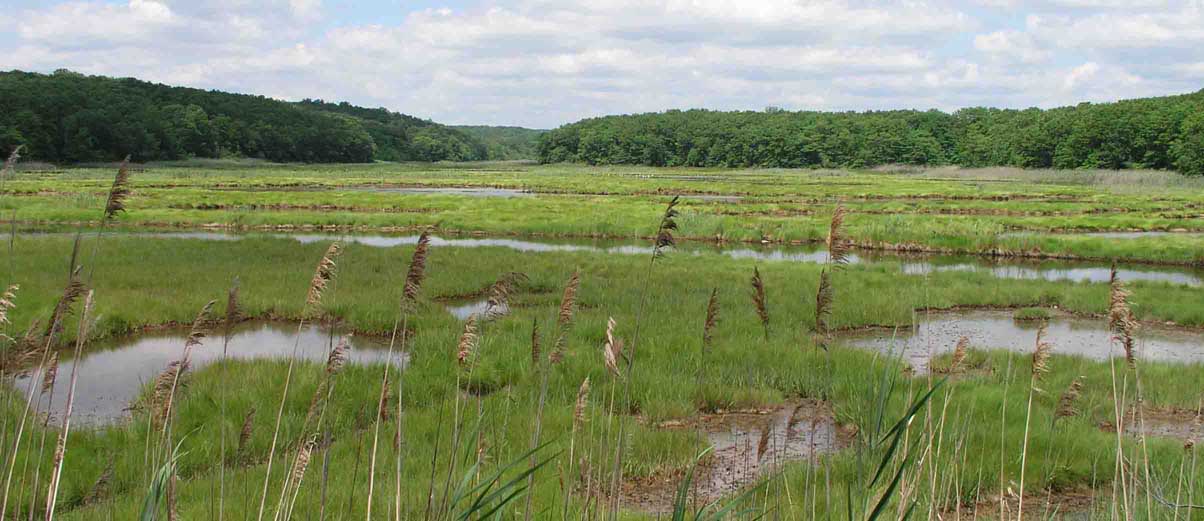Panne on:
[Wikipedia]
[Google]
[Amazon]
 Salt pannes and pools are water retaining depressions located within
Salt pannes and pools are water retaining depressions located within  * Low salt marsh panne
Usually devoid of vegetation, that may be present include smooth cordgrass (''
* Low salt marsh panne
Usually devoid of vegetation, that may be present include smooth cordgrass ('' Minimal vegetation often found on the upper half of the high salt marsh. It is typically deeper than forb and smooth cord-grass pannes. Usually flooded by the higher of the two
Minimal vegetation often found on the upper half of the high salt marsh. It is typically deeper than forb and smooth cord-grass pannes. Usually flooded by the higher of the two
 Brackish marsh panne variants occur in brackish marshes (short graminoid variant), one of the native dominant species is spike grass ('' Distichlis spicata''), some brackish marsh pannes are dominated by the narrow-leaved cattail ('' Typha angustifolia'') an invasive exotic species.
* Mixed
Brackish marsh panne variants occur in brackish marshes (short graminoid variant), one of the native dominant species is spike grass ('' Distichlis spicata''), some brackish marsh pannes are dominated by the narrow-leaved cattail ('' Typha angustifolia'') an invasive exotic species.
* Mixed ECOLOGICAL SYSTEM: NORTHERN ATLANTIC COASTAL PLAIN TIDAL SALT MARSH
 Salt pannes and pools are water retaining depressions located within
Salt pannes and pools are water retaining depressions located within salt
Salt is a mineral composed primarily of sodium chloride (NaCl), a chemical compound belonging to the larger class of salts; salt in the form of a natural crystalline mineral is known as rock salt or halite. Salt is present in vast quantitie ...
and brackish
Brackish water, sometimes termed brack water, is water occurring in a natural environment that has more salinity than freshwater, but not as much as seawater. It may result from mixing seawater (salt water) and fresh water together, as in estuari ...
marsh
A marsh is a wetland that is dominated by herbaceous rather than woody plant species.Keddy, P.A. 2010. Wetland Ecology: Principles and Conservation (2nd edition). Cambridge University Press, Cambridge, UK. 497 p Marshes can often be found at ...
es. Pools tend to retain water during the summer months between high tides, whereas pannes generally do not. Salt pannes generally start when a mat of organic debris (known as ''wrack'') is deposited upon existing vegetation, killing it. This creates a slight depression in the surrounding vegetation which retains water for varying periods of time. Upon successive cycles of inundation and evaporation the panne develops an increased salinity
Salinity () is the saltiness or amount of salt dissolved in a body of water, called saline water (see also soil salinity). It is usually measured in g/L or g/kg (grams of salt per liter/kilogram of water; the latter is dimensionless and equal ...
greater than that of the larger body of water. This increased salinity dictates the type of flora and fauna able to grow within the panne. Salt pools are also secondary formations, though the exact mechanism(s) of formation are not well understood; some have predicted they will increase in size and abundance in the future due to rising sea levels
Rising may refer to:
* Rising, a stage in baking - see Proofing (baking technique)
*Elevation
* Short for Uprising, a rebellion
Film and TV
* "Rising" (''Stargate Atlantis''), the series premiere of the science fiction television program ''Starga ...
.
Salt pannes and pools are unique microhabitats dominated by various species of halophytes, benthic
The benthic zone is the ecological region at the lowest level of a body of water such as an ocean, lake, or stream, including the sediment surface and some sub-surface layers. The name comes from ancient Greek, βένθος (bénthos), meaning "t ...
plants and varying estuarine
An estuary is a partially enclosed coastal body of brackish water with one or more rivers or streams flowing into it, and with a free connection to the open sea. Estuaries form a transition zone between river environments and maritime environment ...
marine life that vary considerably in composition due to a variety of factors:
* Substrate type: affects the ability of the depression to hold water.
* depth and diameter: affect water temperature and evaporation rate in the depression. A shallow and wide pool will evaporate at a greater rate than a pool of the same volume of water which is deeper and has a smaller surface area. Evaporation rate also affects salinity, the higher the evaporation rate the higher the salinity, with rates as high as a third greater than ocean water.
* location within the intertidal zone, whether high marsh
High marsh is a tidal marsh zone located above the Mean Highwater Mark (MHW) which, in contrast to the low marsh zone, is inundated infrequently during periods of extreme high tide and storm surge associated with coastal storms. This zone is im ...
or low marsh
Low marsh is a tidal marsh zone located below the Chart datum, Mean Highwater Mark (MHM). Based on elevation, frequency of submersion, soil characteristics, vegetation, microbial community, and other metrics, salt marshes can be divided to into th ...
and distance from the mean low tide mark which affects the length and duration of inundation until the depression is subject to evaporation as well as length of time until the rising tide replenishes the water volume.
These factors affect the types of species which can survive within the various types of salt pannes and pools.
Variants of salt pannes and pools:
Low salt marsh
 * Low salt marsh panne
Usually devoid of vegetation, that may be present include smooth cordgrass (''
* Low salt marsh panne
Usually devoid of vegetation, that may be present include smooth cordgrass (''Spartina alterniflora
''Sporobolus alterniflorus'', or synonymously known as ''Spartina alterniflora'', the smooth cordgrass, saltmarsh cordgrass, or salt-water cordgrass, is a perennial deciduous grass which is found in intertidal wetlands, especially estuarine salt ...
''), marine algae such as knotted wrack ('' Ascophyllum nodosum'') and rockweeds ( Fucus spp.). The substrate is typically soft, silty mud.
High salt marsh
* Arrow-grass (forb) panne
Briefly flooded, very shallow with a moderate amount of vegetation usually dominated by Arrow grass ('' Triglochin maritimum''), with the deeper sections possibly remaining unvegetated.
* Smooth cord-grass (short form) panne
Shallow anaerobic depressions with poor drainage, poor water quality due to low nutrient levels and high concentrations of sulfide
Sulfide (British English also sulphide) is an inorganic anion of sulfur with the chemical formula S2− or a compound containing one or more S2− ions. Solutions of sulfide salts are corrosive. ''Sulfide'' also refers to chemical compounds lar ...
s and similar compounds which inhibit plant growth. Short form (6-12" tall)smooth cord-grass (Spartina alterniflora) is the dominant plant species. Typically found on the high salt marsh, but can occasionally be found on the upper margins of low salt marsh.
Salt marsh mosquito panne
 Minimal vegetation often found on the upper half of the high salt marsh. It is typically deeper than forb and smooth cord-grass pannes. Usually flooded by the higher of the two
Minimal vegetation often found on the upper half of the high salt marsh. It is typically deeper than forb and smooth cord-grass pannes. Usually flooded by the higher of the two spring tide
Tides are the rise and fall of sea levels caused by the combined effects of the gravitational forces exerted by the Moon (and to a much lesser extent, the Sun) and are also caused by the Earth and Moon orbiting one another.
Tide tables ca ...
s, retains water for 2–3 weeks later until drying out. The female eastern salt marsh mosquito (''Aedes sollicitans
''Aedes sollicitans'', the eastern saltmarsh mosquito (also known as ''Ochlerotatus sollicitans''), is a species of mosquito native to the eastern seaboard of the United States and Canada as well as the entire Gulf coast and is also present in t ...
'') lays eggs on the exposed surface. The eggs lay dormant until the next time the panne floods.
Widgeon grass (''Ruppia maritima
''Ruppia maritima'' is an aquatic plant species commonly known as beaked tasselweed, ditch grass, tassel pondweed and widgeon grass. Despite its scientific name, it is not a marine plant; is perhaps best described as a salt-tolerant freshwater ...
'') - marsh minnow deepwater pool. Pools on the high salt marsh that are semi-permanently and permanently flooded. They are able to sustain populations of Sheephead minnow (''Cyprinodon variegatus variegatus''), Mummichogs, (Fundulus heteroclitus), and other species of small fish which may become trapped in the pools and benthic
The benthic zone is the ecological region at the lowest level of a body of water such as an ocean, lake, or stream, including the sediment surface and some sub-surface layers. The name comes from ancient Greek, βένθος (bénthos), meaning "t ...
species of vegetation. Occasionally can be found at the upper edge of the low salt marsh.
Brackish water marsh
 Brackish marsh panne variants occur in brackish marshes (short graminoid variant), one of the native dominant species is spike grass ('' Distichlis spicata''), some brackish marsh pannes are dominated by the narrow-leaved cattail ('' Typha angustifolia'') an invasive exotic species.
* Mixed
Brackish marsh panne variants occur in brackish marshes (short graminoid variant), one of the native dominant species is spike grass ('' Distichlis spicata''), some brackish marsh pannes are dominated by the narrow-leaved cattail ('' Typha angustifolia'') an invasive exotic species.
* Mixed graminoid
In botany and ecology, graminoid refers to a herbaceous plant with a grass-like morphology, i.e. elongated culms with long, blade-like leaves. They are contrasted to forbs, herbaceous plants without grass-like features.
The plants most ofte ...
- forb panne
Shallow depressions flooded for only for a brief time and are characterized by a variable mix of graminoids and forbs. Frequent herbs include three-square rush (Scirpus pungens
''Schoenoplectus pungens'' is a species of flowering plant in the sedge family known as common threesquare, common three-square bulrush and sharp club-rush. It is a herbaceous emergent plant that is widespread across much of North and South Am ...
), stout bulrush (S. robustus), arrow-grass, marsh creeping bent-grass (Agrostis stolonifera
''Agrostis stolonifera'' (creeping bentgrass, creeping bent, fiorin, spreading bent or carpet bentgrass) is a perennial grass species in the family Poaceae.
Description
''Agrostis stolonifera'' is stoloniferous and may form mats or tufts. The ...
), salt-loving spike-rush ('' Eleocharis halophila''). Growing with less frequency are red fescue ('' Festuca rubra''), New York aster (''Symphyotrichum novi-belgii
''Symphyotrichum novi-belgii'' (formerly ''Aster novi-belgii''), commonly called New York aster, is a species of flowering plant. It is the type species for '' Symphyotrichum'', a genus in the family Asteraceae, whose species were once conside ...
'') silverweed, saltmeadow cordgrass ('' Spartina patens''), and salt marsh rush.
* Sparsely vegetated panne
Saturated, mud dominated pannes are occasionally found in the transition zone next to forested uplands where they are shaded by overhanging tree branches thus inhibiting evaporation. This is the preferred habitat for the uncommon seaside crowfoot ('' Ranunculus cymbalaria''), where prostrate colonies may form small patches over the soil surface. Other graminoids and forbs scattered across the mud, or more often around the panne edge, include Virginia wild rye (''Elymus virginicus
''Elymus virginicus'', or Virginia wildrye, is a perennial bunchgrass located in Virginia and the eastern United States. Virginia wild rye is one of the few cool season native grasses found in the east Texas area. It is extremely palatable to liv ...
''), chaffy salt sedge ('' Carex paleacea'') seaside goldenrod (''Solidago sempervirens
''Solidago sempervirens'', the seaside goldenrod or salt-marsh goldenrod, is a plant species in the genus ''Solidago'' of the family Asteraceae. It is native to eastern North America and parts of the Caribbean. It is an introduced species in the ...
''), marsh creeping bent grass, New York aster and smooth cordgrass.References
{{Wetlands Coastal and oceanic landforms Coastal geography Estuaries Water Wetlands